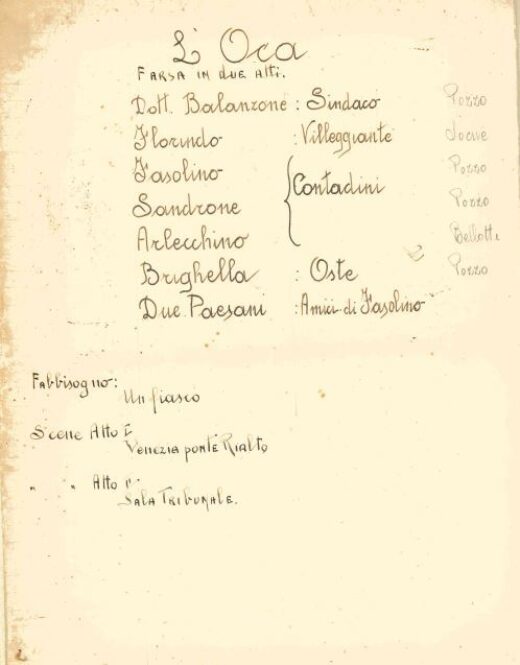
Manuscript
21 pages
Author(s)
L'Oca
This play was adapted from a musical farce of the end of the 19th performed with live actors. It was written by Nino Pozzo with Ezio Bellotti. The manuscript was calligraphed by Carlo Soave. The action is set in Venice, as proved by one of the backcloth picturing the Rialto Bridge.
The victim of a theft seeks justice
Fasolino and his companions enter the stage singing a song about a goose that was stolen in a henhouse and cooked by the innkeeper Brighella. Sandrone expresses his anger, as his most beautiful goose has been taken; he suspects Fasolino to be the thief. He gets close to the place where Fasolino and the other characters are eating, and he hears them sing. Sandrone recognises Fasolino’s voice and asks Brighella to confirm that he is in the inn. Brighella certifies it and Sandrone lashes out on Fasolino, but Brighella goes back to serve his clients and advises Sandrone to watch his language.
Florindo arrives with Arlecchino, who reveals to Sandrone that, during the night, Gervasa’s son saw Fasolino with a goose on his shoulders heading to Brighella’s inn with other people. Sandrone wants to call several people to punish Fasolino and his accomplices, but Florindo urges him to be careful because it would make him guilty and could force him to face a trial. Instead, he advises him to go see the Mayor and file a complaint. However, Sandrone does not trust justice, and his anger increases when he hears Fasolino loudly rejoicing to be eating the goose. Florindo promises to help Sandrone, and Arlecchino accompanies Sandrone to see the Mayor.The second act begins with Balazone’s monologue about the deposition of Sandrone. Florindo arrives and says that he is on holiday and, talking about various things, offers to attend the trial for the theft of the goose. Sandrone is questioned, and Balanzone puts him in a difficult position. He assures him that he has two witnesses, but Fasolino announces that he has fifteen or twenty of them, which, according to Balanzone, should make him win the trial. Arlecchino steps in as Sandrone’s witness, but Balanzone accuses him of having made a false testimony. Florindo reveals that he is the first judge and president of the court, declares Dottor Balanzone’s work to be unsuitable, and accuses Fasolino and his accomplices of having stolen Sandrone’s goose. He announces that a trial will take place. The play ends with a moral addressed to the audience.
